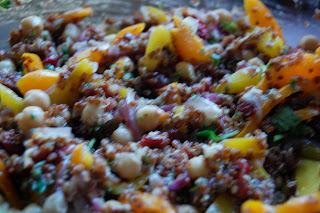Does the Glycemic Index Lead to the Land of the Lean?
Does the Glycemic Index Lead to the Land of the Lean?
By Suzanne W. Dixon, MPH, MS, RD
It seems that every time you turn around, you hear about the glycemic index (GI). “You Can Turbo-Charge Your Metabolism, Create Life Long Motivation & Lose Up to 19 Pounds Of Fat In Just 21 Days Or Less – Guaranteed…!” touts a GI-based weight loss program sold online. “This is the only diet concept that results in MASSIVE weight loss…” continues the hard-sell.
Could it really be that simple? Is it possible that by incorporating this idea into your eating habits, you can forever shed your pounds and end your weight battles? Unlikely. After all, if it were that easy, wouldn’t everyone be doing this?
By the Numbers
The glycemic index (GI) provides a way of ranking carbohydrates according to their effect on our blood sugar level. The higher the number the more quickly a carbohydrate will raise blood sugar. GI tells us how quickly 50 grams of carbohydrate from a specific food will turn into blood sugar in the body, as compared to a reference food – typically white bread or white table sugar.
The reference food is assigned a value of 100. A GI below 100 indicates carbohydrates from that food are absorbed more slowly than carbohydrate from white bread or sugar. Carbohydrates from foods that have a GI above 100 are absorbed more quickly than white bread or sugar carbs.
What’s Glycemic Load?
Although most people are not familiar with glycemic load (GL), this measure actually is more useful than GI. GL takes into account the GI of a food and to this it adds an adjustment for how many carbohydrates are in a normal serving size. To see why GL is more useful than GI, we can compare carrots and white pasta.
The GI of carrots is 131, while pasta has a GI of 71 (1). Based on these numbers, we conclude that carrots are an “unhealthy”, high-GI food. We are incorrectly led to believe that carrots are worse for our health, and our waistlines, than a big bowl of pasta. However, one large carrot (a serving) contains just 4 grams of carbohydrate ... and a low, healthy glycemic load of 5.2. One serving of pasta, about a cup cooked, provides 40 grams of carbohydrate. The glycemic load for a serving of pasta is quite high at 28 1. In order to have the same glycemic load from carrots, you'd have to eat nearly two pounds of them! This shows how glycemic index can be misleading.
The bottom line is that a high GI food, when eaten in a normal serving size, is not necessarily going to derail our weight loss efforts or ruin our health.
Ditching the GI, Improving Our Eating Habits
One positive result about the attention to glycemic index is that it has raised our awareness of the quality of carbohydrates. GI is a less-than-perfect measure of carbohydrate quality, but it gets us thinking about which carbs really are the better choice.
Remember this tip for making healthier carb choices: three things – protein, fat, and fiber – slow the absorption and conversion of carbohydrate from food into glucose in our blood stream. That’s right. Simply combining the carbohydrates you do eat with fiber, lean protein, and/or healthy fat brings both the GI and the GL of the total snack or meal down to a healthy level.
The Practicalities
You can picture how this works by considering fruit and fruit juice. The GI and GL of whole fruit are much lower than fruit juice, because the fiber in the whole food slows the absorption of the carbs. Consider snacking on a piece of fruit and a handful of nuts, which provide all three – protein, healthy fat, and fiber! Or try a snack of carrots and hummus or bean dip – again, a stealthy, healthy way to keep the GI and GL low.
Make sure every meal includes a lean protein, such as beans, wild-caught fish, organic chicken, tofu, tempeh, or grass-fed, lean beef. The options are endless, but the key is to keep your eye on the prize: by combining protein, fat, and/or fiber into every meal and snack, you will better regulate your appetite, keep your blood sugar and insulin levels steady, and aid your weight management efforts.
We’ve all been hoping for the proverbial “free lunch” – easy weight management and good health while eating whatever suits our fancy. Unfortunately, nature doesn’t work that way. But lucky for us, nature does provide the perfect nourishment in the form of healthy, whole, minimally processed foods.
Your Take Home Message
In general, carbohydrates that look much like they did when coming from the branch, off the vine, or out of the ground are the best choices. You don’t need a label to tell you that apples, carrots, broccoli, or plain oatmeal are healthy choices. The funny thing is, we’ve probably known this all along.
References
Willett, W. Eat, Drink, and Be Healthy: The Harvard Medical School Guide to Healthy Eating. Simon & Schuster. 2001.
For full issue, visit http://www.appleboost.com/pages.php?pID=32.
-
Do this one thing for stronger bones
Osteoporosis is the loss of bone density. It is more prevalent
-
How To Burn The Fat Without External Aid
The influx of weight loss and diet produ
-
Exercising To Flatten Your Belly
The very first and most important step into developing a six pack
-
Weight Loss And The Theory Of Constraints
Its always been fascinating to me how business, finance and weight los
-
Reading Food Labels - Its Easy
Being aware of what you eat is a key whe
-
How to Acquire a Well Toned Body - 2 Exercise Methods that Ensure Quick Result
Heres a fact that you have to accept fir
- DON'T MISS
- Atkins Diet
- Weight Loss Tips; Getting Started
- Weight Loss Pills – Why Choose Hoodia Diet Pills For Effective Weight Loss?
- Four Essential Factors Required In Any Diet Solution Program
- Chitosan Diet Pills
- Diet System Tips Experts Provide
- Sugar — The Sweet And The Bad!
- Two Main Causes of Eating Disorders
- Your Pre-Teens Weight
- Eat Lean and Clean - Quick and Simple




